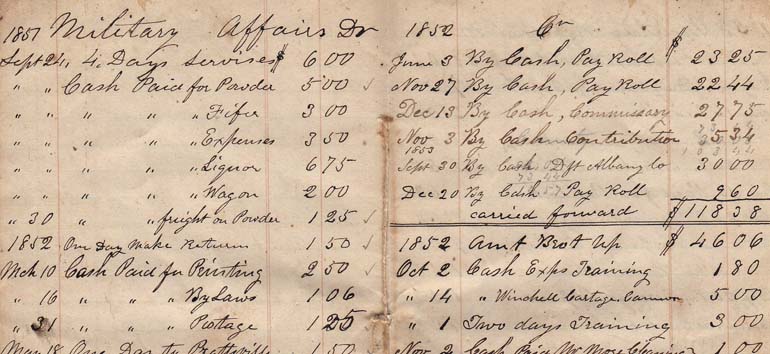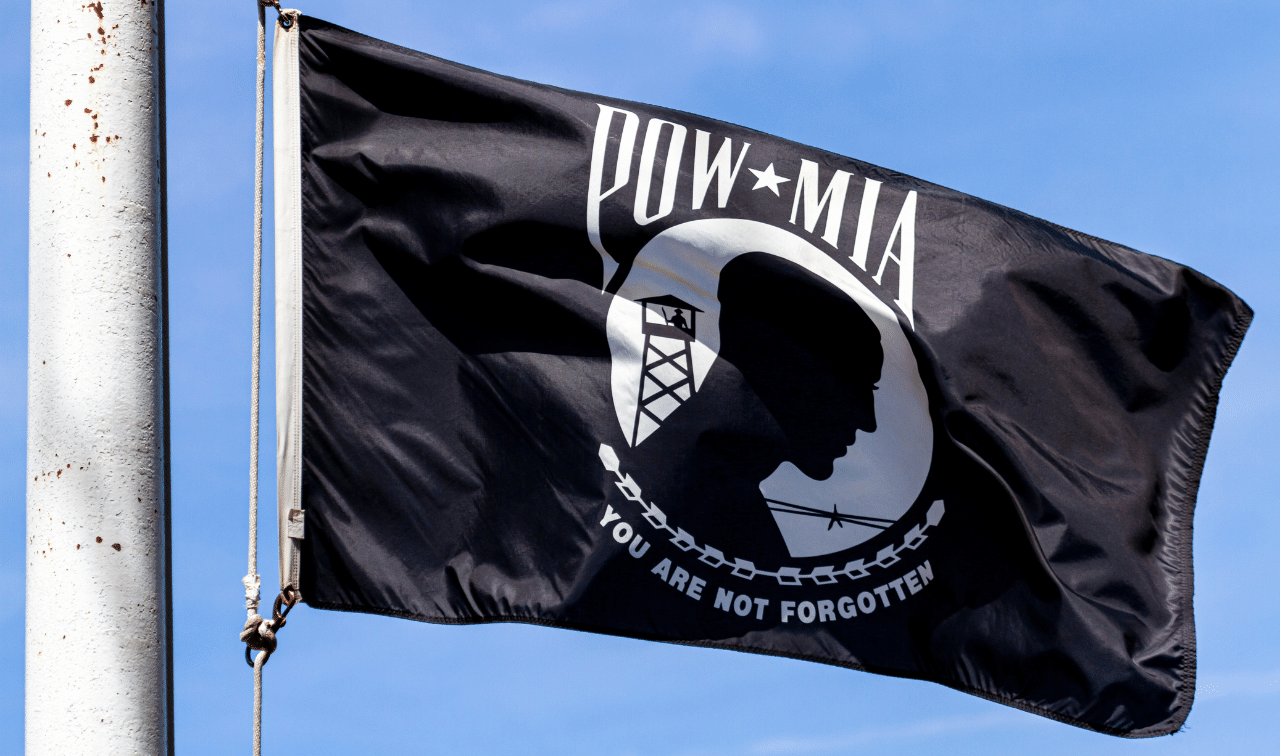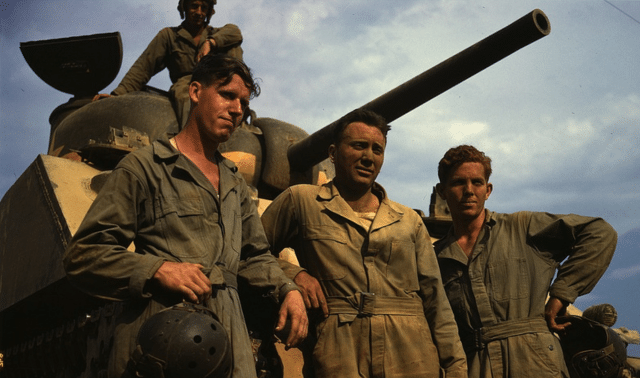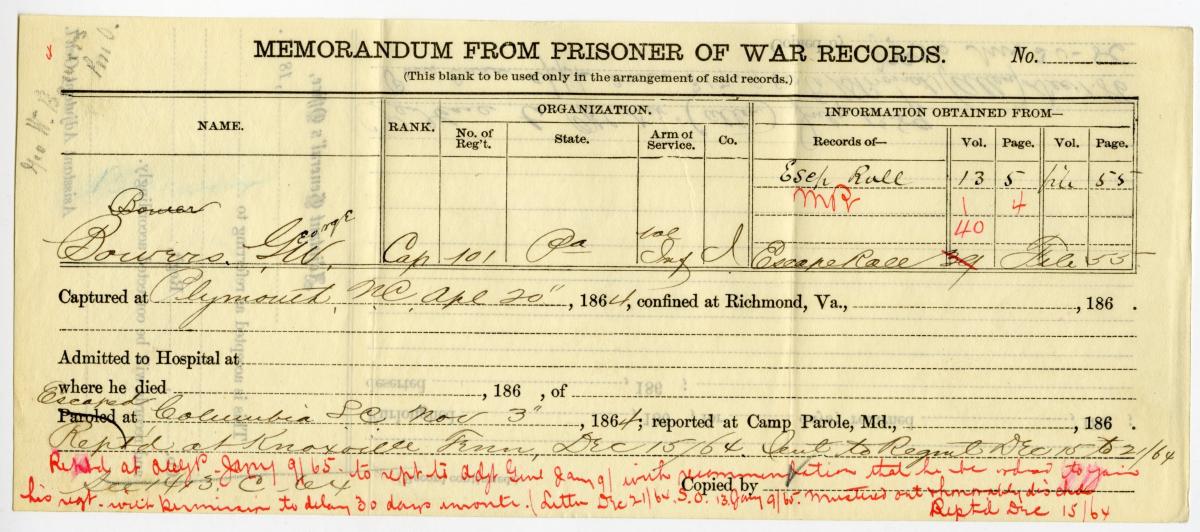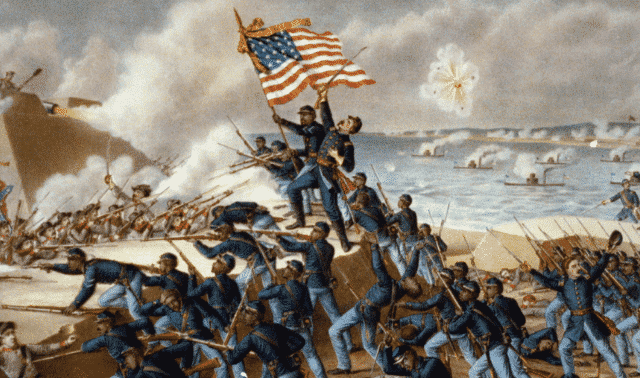Sign up for the Family Tree Newsletter! Plus, you’ll receive our 10 Essential Genealogy Research Forms PDF as a special thank you.
Get Your Free Genealogy Forms
"*" indicates required fields
Table of Contents
How do I find out if I have ancestors in the Civil War?

Search the Civil War Soldiers and Sailors Database
This free National Park Service site indexes more than 6 million soldiers (some are named multiple times because they re-enlisted with different units) and 18,000 African-American sailors. You’ll learn their side, state served from battle unit/regiment, function (such as infantry or cavalry), and other names used.

Obtain service and pension records
Use your soldier’s information to locate his service records. Search for the soldiers name in pension indexes to determine whether he or his widow, minor child or dependent parent filed for a pension.

Find burial info
The first National Cemeteries were established in 1862 for Civil War dead. All honorably discharged veterans (including of the Confederacy) became eligible for burial in a national cemetery in 1873. Sadly, many Civil War veterans were buried unidentified. For those who were identified, the Veterans Administration Gravesite Locator covers veterans and their families buried in national and state veterans cemeteries, as well as in private cemeteries if the government issued an official grave marker for the person. You also can check published sources such as the Roll of Honor series for Union deaths and Deaths of Confederate Soldiers in Confederate Hospitals for Confederate deaths.

Seek additional records
Look for records with other sources listed in our records chart and search libraries for collections that may hold helpful information. Check large public and university libraries and your ancestral state archives for holdings of Civil War journals, letters, manuscripts and more. Search newspapers for your ancestor, his service unit and battles he fought.

Learn more about your Civil War relative’s experiences
Start learning more about your Civil War relative’s experiences with the unit histories at CWSS and on Civil War websites. Also check The War of the Rebellion: A Compilation of the Official Records of the Union and Confederate Armies (the “OR”) for Union and Confederate battle reports, correspondence, orders and more. Peruse maps of battles at the Civil War Trust and Library of Congress.
Map

(David Rumsey Map Collection.)
This map, created in 1864, shows the United States at war. It depicts Union states in yellow, Confederate states in red and Union-held Confederate territory (as of October 4, 1864). Cities highlighted in blue represent “Battle Fields, Strategic and Important places” in the South.
More Resources
LIBRARY OF CONGRESS
AMERICAN BATTLEFIELD TRUST
ARCGIS STORYMAPS
Civil War Terms Glossary
| aide-de-camp: confidential assistant to an officer, responsible for writing and delivering orders, and knowing troop positions and locations of officer quarters | contraband: escaped slaves who fled to the Union lines | private: the lowest army rank |
| artillery: cannon or other large-caliber firearms; a branch of the army armed with cannon | CSA: Confederate States of America | USCT: US Colored Troops |
| battery: basic unit of soldiers in an artillery regiment | earthwork: a field fortification (such as a trench or mound) made of earth, used to protect troops and slow the enemy | vidette/vedette: a mounted sentry on picket duty |
| cavalry: a branch of an army mounted on horseback | garrison: group of soldiers stationed at a military post | vivandière or cantinière: a woman attached to a military regiment as a sutler (merchant), canteen keeper, nurse or other caretaking capacities |
| commutation: Union and Confederate government practice allowing draftees to pay a fee rather than serve in the military | Mason-Dixon line: a boundary surveyed in the 1760s between Pennsylvania to the North and Delaware, Maryland and Virginia to the South. It later became a symbolic border between free and slave states. | volunteer: those who enlisted specifically for the war, in a federal or state militia unit |
| CMSR: compiled military service record | muster: to formally enlist in the army, a roll call | zouave: a Union or Confederate regiment known for its bright, colorful uniforms, modeled after French African troops |
| conscript: a person drafted into the military | picket: an advance outpost or guard for a larger force, considered the most hazardous infantry assignment |
Civil War Military Records
The Civil War produced voluminous documents about the more than 3.5 million men (and a few hundred women) who fought both for the Union and the Confederacy. But because military records don’t fit the familiar patterns of most genealogical research – vital records, wills, passenger lists and the like – they can seem daunting to a first-time researcher. Fortunately, understanding a few key facts and a handful of essential resources can unlock a wealth of information about your Civil War ancestor.
Compiled Military Service Record (CMSR)
Every soldier has a CMSR for each regiment he served in, so if your ancestor was in more than one, seek out all his CMSRs. The CMSR envelope, with contents compiled from original muster rolls and other records, contains various cards typically recording whether the soldier was present during a period of time, facts of enlistment and discharge, and any wounds or hospitalization.
Pension records
If your ancestor fought for the Union, it’s likely he, his widow or his minor children later applied for a pension. Surprisingly, these pension files often contain richer information about a soldier’s service than his CMSR does, including a medical history if he lived for a number of years after the war. Pension files can be a genealogical gold mine for researching the family, too: Widows had to supply evidence of marriage, and applicants on behalf of minor children had to prove their birth and the soldier’s marriage.
Draft records
Draft records include much genealogical data, even if your ancestor never actually served. Consolidated Lists show each man’s name, residence, age, occupation, marital status, place of birth and any previous military service. Descriptive Rolls include physical description, birthplace and whether the person was enlisted. Both listings are organized by state, then congressional district, then surname.
Census records
Yes, those decennial head counts so familiar to family tree researchers sometimes hold clues about Civil War service. The 1890 census included a special enumeration of Union veterans and widows. Most of that census was lost to fire, but those special schedules survived for states alphabetically from Kentucky through Wyoming.
Grand Army of the Republic records
After the war, many Union veterans joined organizations such as the Grand Army of the Republic (GAR) – by 1890, some 40 percent of Union veterans were GAR members. The records of local GAR posts, including rosters and meeting minutes, often provide genealogical information about members.
Cemetery records
Whether it happened during the war or years later, all Civil War veterans have passed on-and cemetery records yield more ancestral clues. If you think your Civil War ancestor is buried in a government cemetery, start your search at the Department of Veterans Affairs’ National Gravesite Locator. This site indexes burial locations of veterans and their families in VA national cemeteries, state veterans cemeteries and other military and Department of Interior cemeteries.
Regiment history
Once you’ve researched your ancestor’s military records, you can learn much more about his Civil War experiences by studying his regiment and company. For a quick regimental history, including major battles, just click on the CWSS site’s Regiments link. Civil War buffs and soldiers’ descendants have written legions of printed and online histories.
Photos and maps
Nothing brings your ancestors’ world alive like images. Photographers such as the legendary Mathew Brady made the Civil War the first military conflict captured in pictures, showing uniforms, weapons, camp life and battle aftermath. Maps let you trace the movements and battlefield positions of your soldier’s unit.
David Fryxell
Civil War-era Southern Ancestor Records
Black or white, wealthy or without means, your ancestors in former slaveholding states likely experienced some turbulent times. This upheaval may be reflected in the records you’re searching. Here are additional records to consider researching when trying to find your Southern ancestors after the Civil War.
Southern Claims Commission records
In 1871, the federal government’s Southern Claims Commission began processing claims for reimbursement of Southern livestock and property taken by Union troops during the war. An estimated 10 percent of Southerners (black and white, rich and poor) appear in testimony or discussion of claims of their neighbors and relatives.
Confederate pardons
President Andrew Johnson pardoned many Confederates by proclamation; others had to apply for amnesty and take oaths of allegiance. Applications for pardons include the petitioner’s residence, helping you locate an ancestor.
Voting registrations
Federal rules of Reconstruction required that Southern states register black and white voters. Loyalty oaths were part of the qualification process.
Freedman’s Bank registers
From 1865 to 1874, the Freedman’s Bank served black clients in major (mostly Southern) US cities. Registers of depositors’ signatures often include birthplaces, residences, former slaveholders’ and/or plantation names, relatives’ names and other clues to where someone lived or came from.
Freedmen’s Bureau records
For seven years after the war, the Bureau of Refugees, Freemen and Abandoned Lands administered relief to the white and black poor and recorded black marriages, labor contracts, indentures (often between black workers and white employers) and more.
Land and tax records
Even if your relatives disappeared, their property didn’t. If they owned land, you may be able to trace its ownership forward or backward. You also may find ancestral lands and personal property assessed in tax records. These documents often hold clues about when, where and even why families moved.
Sunny Jane Morton
More Resources
FOLD3
ONLINE MILITARY INDEXES AND RECORDS – USA
NATIONAL ARCHIVES
Civil War Photography
The Civil War is the first military conflict for which we have an extensive photographic record. Cartes de visite—from the French for “calling card” and pronounced “cart-de-vee-zeet”—abound even today because of the extremely high number of them made. The daguerreotype was introduced in 1839, but by the time of the Civil War, photographs were cheaper and more accessible.
Lynn Ewbank
Tips to Finding Your Ancestor’s Civil War Photos
- Check with relatives
- Post a query online
- Search reunion site such as DeadFred.com and AncientFaces.com
- Try searching the U.S. Army Heritage & Education Center
- Contact local and state historical societies to see if they have relevant images
Exploring Civil War Photos
Perhaps you want to learn more about a Civil War-era photograph you’ve inherited. Fortunately, the clues are right there, revealed in the type of image, the case enclosing it (if any), the clothing your ancestors wore, and the props and backdrop around them.
Maureen Taylor, The Photo Detective
More Resources
CIVIL WAR PHOTO SLEUTH
Using technology and community to rediscover lost identities in American Civil War-era photographs
LIBRARY OF CONGRESS
THE CENTER FOR CIVIL WAR PHOTOGRAPHY
Civil War US Colored Troops
Free African Americans and runaway slaves had already seen Civil War action when President Lincoln authorized black troops in the Emancipation Proclamation Jan. 1, 1863. At least three African American Union regiments had been raised in New Orleans; they later became part of the Corps d’Afrique. In fall 1862, the 1st Kansas Colored Infantry fought at Island Mound, Mo., and three companies of the 1st South Carolina Infantry (African Descent) had joined coastal expeditions.
Early in 1863, Massachusetts organized the first black regiment in the North. That July 18, the state’s 54th Infantry led an assault on Fort Wagner, SC, a drama made famous in the 1989 movie Glory.
The US Colored Troops (USCT) didn’t come into being until May 22, 1863, when the government gave that designation to all African-American units and created the Bureau of Colored Troops. It was another year before Congress granted those soldiers the same pay as their white comrades.
In all, 18,000 African-Americans served in 163 Union Army units; 18,000 served in the Navy. Learn more about the USCT at the National Archives website. USCT soldiers are part of the Civil War Soldiers and Sailors System database, as are African-Americans who served in the Navy. You’ll find soldiers’ service records on the free FamilySearch.org and Ancestry.com. They’re also on microfilm at the National Archives and the Family History Library. Also look for deeds of manumission, oaths of allegiance, proof of ownership, certificates of monetary award and bills of sale. These appeared most often for regiments from Kentucky, Maryland, Missouri and Tennessee—slave states that stayed in the Union. To facilitate recruitment, the War Department compensated citizens of these states up to $300 for signing oaths of loyalty to the Union and manumission (release) papers for their slaves who enlisted.
Diane Haddad
More Resources
AFRICAN AMERICAN CIVIL WAR MEMORIAL MUSEUM
INTERNATIONAL AFRICAN AMERICAN MUSEUM
Did Your Ancestor Serve in the United States Colored Troops (USCT)?
NATIONAL ARCHIVES
Genealogy Q&A: Indigenous Peoples in the Civil War
Q: How do I trace an American Indian when all I have is the name the Army gave him when he became an Indian scout around the Civil War era?
A: You’re fortunate to have that English name for your ancestor. It will help you research backward, so you can learn your ancestor’s American Indian name and tribe.
Q: I’m trying to find out info about a Seneca Indian in Civil War service. Where do you recommend I look?
A: We seldom hear about American Indian participation in the Civil War, but up to 29,000 Native Americans served on either side. A Seneca lawyer and Union general, Ely S. Parker, was the military secretary for Ulysses S. Grant and actually drew up the articles of surrender signed by Robert E. Lee at Appomattox Courthouse.
To see which regiment your ancestor served with, look him up at the Civil War Soldiers and Sailors Database.
David Fryxell
More Resources
FAMILYSEARCH
CITY OF ALEXANDRIA, VIRGINIA
NATIONAL ARCHIVES
Lead the Way: Researching U.S. Army Indian Scouts, 1866–1914
Civil War Timeline

Abraham Lincoln is elected president
South Carolina votes to secede
Mississippi, Florida, Alabama, Georgia, Louisiana and Texas secede
Jefferson Davis is elected president of the Confederacy

Southern troops fire upon Fort Sumter
Lincoln calls for 75,000 volunteers for the Federal army
Lincoln proclaims blockade of Southern ports
Virginia (minus its western counties), Arkansas, Tennessee and North Carolina secede
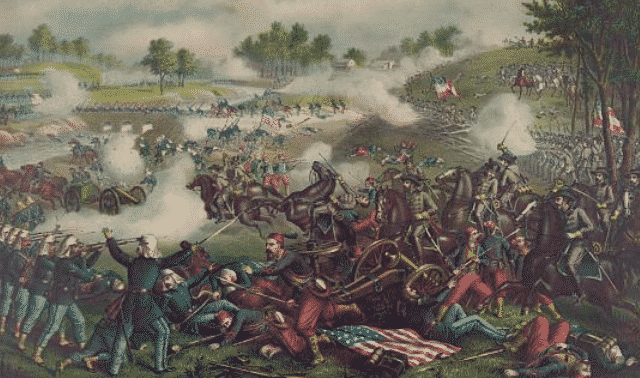
First Battle of Bull Run (Manassas) is fought in Virginia
Kurz & Allison. (ca. 1889) Battle of Bull Run–July 21st –Federal Gen. McDowell … Confederate Gen. Beauregard. Virginia Manassas, ca. 1889. , C1890. [Photograph] Retrieved from the Library of Congress.
CSS Virginia and USS Monitor fight at Hampton Roads
Union wins Battle of Shiloh
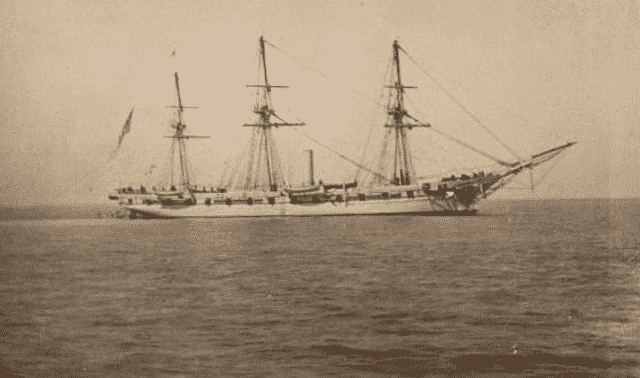
Union Adm. David Farragut captures New Orleans
Mcpherson & Oliver, photographer. (1864) USS Hartford, flagship of Admiral David Farragut during the Civil War / McPherson & Oliver, photographers, 132 Canal Street, upstairs. United States, 1864. [New Orleans: McPherson & Oliver, photographers, 132 Canal Street, upstairs] [Photograph] Retrieved from the Library of Congress.
Second Battle of Bull Run results in 22,000 casualties
Battle of Antietam is the first major battle on Union soil
Union suffers a devastating loss at Fredericksburg, Va.

Emancipation Proclamation frees slaves in Confederate territory
Death of Gen. Thomas Jonathan “Stonewall” Jackson tempers Southern victory at Chancellorsville

Battle of Gettysburg is the war’s bloodiest

Siege of Vicksburg, Miss., ends with the city’s surrender
Irish workers initiate draft riots in New York City
Confederate submarine
H.L. Hunley sinks after attacking the USS Housatonic

First Union prisoners arrive at Andersonville Prison, Ga.
(ca. 1865) Andersonville prison. Georgia. , ca. 1865. Sept. 28. [Photograph] Retrieved from the Library of Congress.
Gen. Ulysses S. Grant becomes commander of the Union army

More than 7,000 men are killed in 20 minutes at the Battle of Cold Harbor (Virginia)
Reekie, J., photographer. Confederate lines at Cold Harbor, Va. United States Cold Harbor Virginia, None. [Photographed 1865 april printed between 1880 and 1889] [Photograph] Retrieved from the Library of Congress.
Union troops occupy Atlanta
Gen. Lee evacuates the Confederate capital, Richmond, Va.

Lee surrenders at Appomattox Courthouse, Va.

John Wilkes Booth assassinates Abraham Lincoln at Ford’s Theater in Washington, D.C.
Union army captures Jefferson Davis in Irwinville, Ga.
Nancy Hendrickson
More Resources
AMERICAN BATTLEFIELD TRUST
LIBRARY OF CONGRESS
BRITANNICA
Civil War Genealogy Research Resources
Websites | Books | Library Reference Books | Organizations | Family Tree Podcasts
CIVIL WAR WEBSITES
Access Genealogy: Civil War Records
Alabama Department of Archives and History: Civil War Records
American Battlefield Trust: Civil War
Black Soldiers in the Civil War
A Brief Introduction to Genealogy and the American Civil War
The Civil War Archive Regimental Index
The Civil War Archive: United States Colored Troops
Civil War and Other Military Mailing Lists
Civil War Soldiers and Sailors Database
Confederate States Navy, Museum, Library & Research Institute
Grand Army of the Republic and Related Research Links
Locating a Union Civil War Soldier
Military History Online: Civil War Genealogy Database
New York Divided: Slavery and the Civil War
North-South Skirmish Association
The Olive Tree Genealogy: Civil War Genealogy & History
Pennsylvania Civil War Volunteers
Prologue: Civil War and Later Navy Personnel Records at the National Archives, 1861-1924
Researching People of the Civil War Era
Sons of the Union Veterans of the Civil War
United Daughters of the Confederacy
Western Maryland Historical Library: Civil War
The War of the Rebellion: A Compilation of the Official Records of the Union and Confederate Armies
CIVIL WAR BOOKS*
America’s Civil War (The American History Series) by Brooks C. Simpson (Harlan Davidson)
The American Heritage New History of the Civil War by Bruce Catton (Viking Books)
An American Iliad: The Story of the Civil War by Charles P. Roland (University Press of Kentucky)
Battle Cry of Freedom: The Civil War Era by James M. McPherson (Ballantine Books)
Bibliography of State Participation in the Civil War, 1861-1866 (Martino Publishing Co.)
The Civil War: A Narrative by Shelby Foote (3 volumes, Random House)
The Civil War: An Illustrated History by Geoffrey C. Ward (companion to the PBS TV series, Knopf)
The Civil War Day by Day: An Almanac 1861-65 by E.B. and Barbara Long (Da Capo Press)
Civil War Genealogy by George K. Schweitzer (Genealogical Sources)
Civil War Sites: The Official Guide to Battlefields, Monuments, and More by the Civil War Preservation Trust (Globe Pequot)
A Compendium of the War of the Rebellion, 3 volumes, by Frederick H. Dyer (National Historical Society)
Confederates in the Attic: Dispatches from the Unfinished Civil War by Tony Horwitz (Random House)
The Confederacy: A Guide to the Archives of the Confederate States of America by Henry Putney Beers (NARA)
Everyday Life During the Civil War by Michael J. Varhola (Writer’s Digest Books)
How the North Won: A Military History of the Civil War by Herman Hattaway and Archer Jones (University of Illinois Press)
Index to the Roll of Honor by Martha and William Reamy (Genealogical Publishing Co.)
Military Bibliography of the Civil War by Charles E. Dornbusch (New York Public Library)
The Official Military Atlas of the Civil War by George B. Davis, Calvin D. Cowles and others (The Fairfax Press)
Official Records of the Union and Confederate Navies in the War of the Rebellion General Index by Dudley W. Knox (Antiquarian Press)
Personnel of the Civil War edited by William Frayne Amann, 2 volumes (Thomas Yoseloff)
Register of Officers of the Confederate States, 1861-1865, Office of Naval Records (J.M. Carroll & Co.)
Official Records of the Union and Confederate Navies in the War of the Rebellion (30 volumes, Government Printing Office)
The Roster of Union Soldiers, 1861-1865 edited by Janet B. Hewett (33 volumes, Broadfoot Publishing)
The Roster of Confederate Soldiers, 1861-1865 edited by Janet B. Hewett (16 volumes, Broadfoot Publishing)
Supplement to the Official Records of the Union and Confederate Armies edited by Janet B. Hewett (51 volumes, Broadfoot Publishing, out of print)
The Union: A Guide to Federal Archives Relating to the Civil War by Kenneth W. Munden and Henry Putney Beers (NARA)
The Unpublished Roll of Honor by Mark Hughes (Genealogical Publishing Co.)
Tracing Your Civil War Ancestor by Bertram Groene (Ballantine Books)
Trials and Triumphs: Women of the American Civil War by Marilyn Mayer Culpepper (Michigan State University Press)
The War of the Rebellion: A Compilation of the Official Records of the Union and Confederate Armies, 70 volumes (Government Printing Office)
Who Was Who in the Civil War by Stewart Sifakis (Facts on File)
CIVIL WAR LIBRARY REFERENCE BOOKS
The Atlas of the Civil War edited by James M. McPherson
Atlas to Accompany the Official Records of the Union and Confederate Armies from the US War Department
Biographical Dictionary of the Confederacy by Jon L. Wakelyn
Biographical Dictionary of the Union: Northern Leaders of the Civil War by John T. Hubbell and James W Geary
Civil War Almanac by John S. Bowman
Civil War Day by Day: An Almanac, 1861-1865 by E.B. Long
Civil War Dictionary by Mark Mayo Boatner
The Civil War Times Illustrated Photographic History of the Civil War edited by William C. Davis
Chronological Tracking of the American Civil War per the Official Records of the War of the Rebellion by Ronald A. Mosocco
A Compendium of the War of the Rebellion by Frederick H. Dyer
Compendium of the Confederate Armies by Stewart Sifakis
Historical Times Illustrated Encyclopedia of the Civil War by Patricia L. Faust
Official Records of the Union and Confederate Navies in the War of the Rebellion (30 volumes)
Photographic History of the Civil War by Francis Trevelyan Miller
Roll of Honor: Names of Soldiers Who Died in Defense of the American Union, Interred in the National Cemeteries from the US Quartermaster’s Department
Roster of Confederate Soldiers, 1861-1865 by Janet B. Hewett
Roster of Union Soldiers, 1861-1865 by Janet B. Hewett
The Sable Arm: Negro Troops in the Union Army by Dudley Taylor Cornish
Union Army, 1861-1865: Organization and Operations by Frank J. Welcher
War of the Rebellion: A Compilation of the Official Records of the Union and Confederate Armies (128 volumes, plus 95-volume supplement and five-volume index)
The West Point Atlas of the Civil War from the US Military Academy
Who Was Who in the Civil War by Stewart Sifakis
Women’s Work in the Civil War: A Record of Heroism, Patriotism and Patience by LP. Brockett and Mary C. Vaughn
CIVIL WAR SOCIETIES AND ORGANIZATIONS
Army Heritage and Education Center
950 Soldiers Drive, Carlisle, PA 17013, (717) 245-3971
Civil War Preservation Trust
1331 H St. N.W., Suite 1001, Washington, DC 20005, (202) 367-1861
Confederate Research Center
Box 619, Hillsboro, TX 76645, (254) 582-2555
Daughters of Union Veterans of the Civil War
503 S. Walnut St., Springfield, IL 62704, (217) 544-0616
Grand Army of the Republic Museum and Library
4278 Griscom St., Philadelphia, PA 19124, (215) 289-6484
Library of Congress
101 Independence Ave. SE, Washington, DC 20540, (202) 707-5000
Library of Virginia
800 E. Broad St., Richmond, VA 23219, (804) 692-3500
Military Order of the Loyal Legion of the United States
1805 Pine St., Philadelphia, PA 19103
National Archives and Records Administration
700 Pennsylvania Ave. NW, Washington, DC 20408, (866) 272-6272
New England Civil War Museum
Thomas J. O’Connell Library
14 Park Place, Vernon, CT 06066, (860) 870-3563
Sons of Confederate Veterans
Box 59, Columbia, TN 38401, (800) 693-4943
Sons of Union Veterans of the Civil War
Box 1865, Harrisburg, PA 17105, (717) 232-7000
United States Civil War Center Hill Memorial Library
Louisiana State University, Baton Rouge, LA 70803, (225) 578-6544
United Daughters of the Confederacy
Memorial Building, 328 North Blvd., Richmond, VA 23220, (804) 355-1636
Family Tree Magazine PODCASTS
* FamilyTreeMagazine.com is a participant in the Amazon Associates Program, an affiliate advertising program. It provides a means for this site to earn advertising fees, by advertising and linking to Amazon and affiliated websites.




















